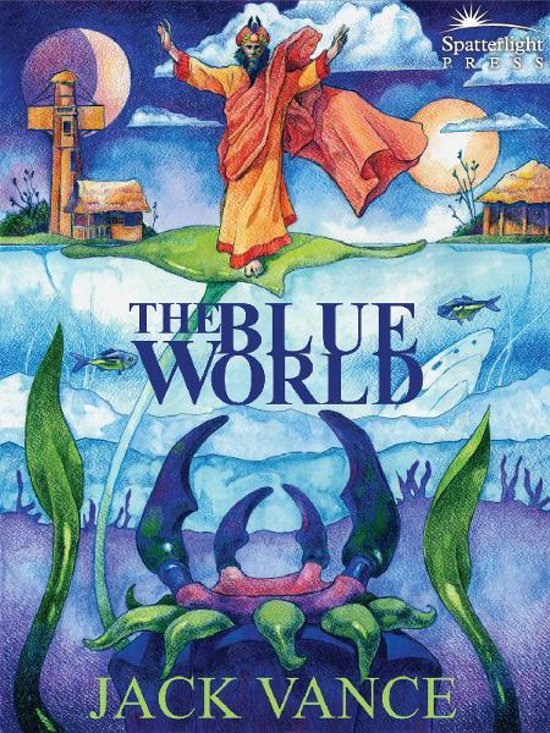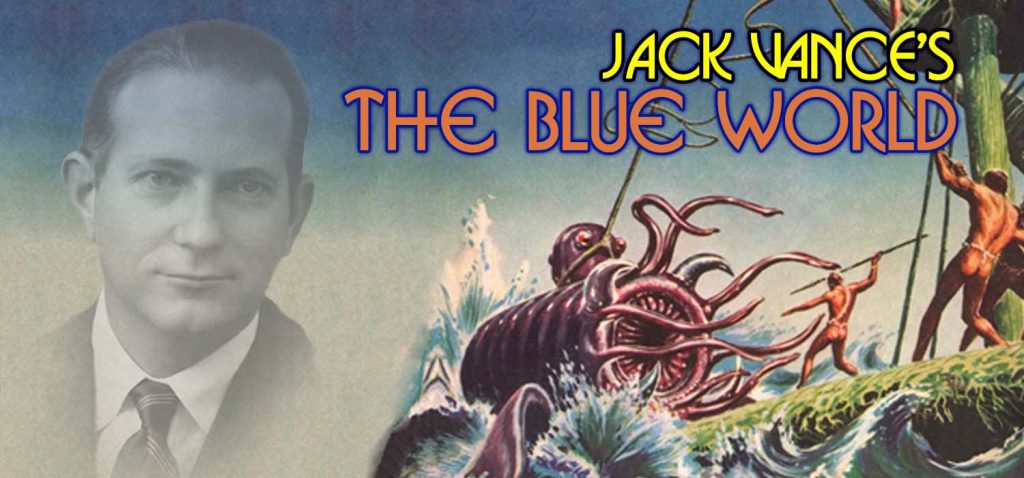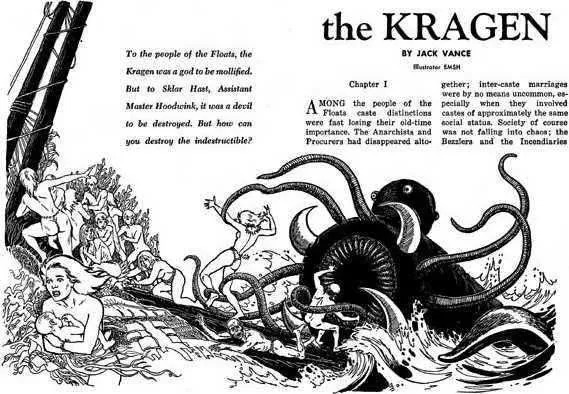Sic Semper Tyrannis Piscis: A Look at Jack Vance’s The Blue World
by Bill Ward
The water world has no name – nor seasons, nor strife, nor struggle. The weather is placid, the conditions mild, the planet’s vast all-encompassing ocean lacks tides, storms, or surges of any kind. Life on the Home Floats is gentle, food is easy to acquire and dependably regular, and conflict virtually unknown. In the twelve generations since planetfall, a handful of human settlers has grown to twelve thousand who live in languid harmony despite a dearth of material resources beyond the basic essentials. The only real danger to the colonists’ idyllic lives on their lily-pad-like floats are the kragen – virtually impenetrable be-tentacled leviathans that accost fisherfolk and decimate sponge-arbor alike. But the people of the Home Floats have a protector, the biggest fish of them all, one fed and fattened for generations until nothing in the ocean – native or human – can stand up to him. King Kragen.
Into this society, “where time drifted, rather than throbbed,” the specter of change arrives in the form of Assistant Master Hoodwink Sklar Hast. Hast is of the Hoodwink caste, those who wink hoods in much the same way that it might be said that members of the Swindler caste swindle fish, both one of many clans going by the ancient honorable roll call of names such as the Bezzlers, Smugglers, Peculators, Larceners, Malpractors, Blackguards, Incendiaries, or Advertisermen. Fleeing unjust persecution in the larger universe, the original members of these castes commandeered the vessel transporting them to wrongful confinement, and established the colony of the Home Floats in the near-forgotten past. Their descendants proudly bear their names, and generally spend their lives working within the traditional roles and humble trades associated with each caste.
Sklar Hast, for example, operates the Hoodwink tower of his home, Tranque Float. Each float has such a communications array for rapid semaphore messaging between stretches of water. With a series of white targets (or lamps, during the evening) each signal tower blinks a complex coded message by opening or shuttering the various targets – by ‘winking’ their ‘hoods.’ Hast is an expert at this, better even than his old Master Zander Rohan, but when we meet him he is content with his station in life, biding his time until he can assume Mastery himself, hoping to marry Zander’s daughter Meril, and generally enjoying the fruits of his labor. But Hast has a quirk – an unbending sense of justice, and one day when a lesser kragen makes free with his own sponge arbors and threatens to burst into the lagoon of Tranque Float itself, Hast does the unthinkable. He fights back.
Vance excels at depicting odd societies and cultures, and people in conflict with them, and doing so in a very concise, and often ironically humorous, way. Hast’s crime is to tread on King Kragen’s prerogative – the ancient compact between man and beast that maintains that to King Kragen, and to he alone, belongs the right to slay kragen. This quasi-religious compact is enforced by the Intercessors – a guild of individuals that propitiate, communicate with, and, as it turns out, direct the actions of the monstrously powerful King Kragen. Tranque Float’s Intercessor is a rival of Hast’s for the affections of Meril Rohan, and Hast, after being sidelined by authorities and cheated in a challenge for the position of Master Hoodwink, and after seeing his own properties destroyed by King Kragen in a too-convenient-to-be-coincidental attack, quickly deduces that the Intercessors are more than they seem. With his first frustrated spear thrust into the eye of a lesser kragen, to his subsequent elaborate schemes and plans to destroy the great tyrant fish itself, Hast launches a revolution upon the blue world.

And ‘schemes and plans’ are one of the delights of The Blue World. An ocean planet with very little in the way of resources beyond those that satisfy the elementary needs of sustenance and shelter, a world where the hardest substance known to the colonists are their very own bones, Vance pays particular heed to the material culture of their society: just how things are built, and from what are they constructed. From the settling of a new float to the construction of weapons against the kragen, Vance’s engineering and nautical background shines through to lend a fascinating verisimilitude to the progression of discoveries and techniques Hast and his compatriots develop during their fight for independence from the tithe and terror of King Kragen. And, while Hast assumes the leadership role and develops a moral philosophy of freedom in what is nothing short of an upending of the old order, others plumb the depths of the original records of the ‘colonists’ to discover not only the truth of their origins (which is amusingly obvious to the reader from the first paragraph!), but scientific principles that unlock previously unsuspected potential in the material world. From scraps of old records and diligent experimentation, a technological revolution is born alongside the political, one that sources metal from blood (copper from the unwilling kragen, iron from human donors) and the very power of lightning – all in service of defeating the terrible leviathan . . . and his masters.
The pushback against Hast and those that support his bid for freedom, who wish to stop “groveling to a sea-beast,” is an equal and opposite one, as the Intercessors go beyond their previously secretive manipulation of King Kragen to create a standing army of thugs to rule the Home Floats, and prosecute a potential war of annihilation and enslavement against Hast’s iconoclastic separatists. The placidity of life in the Home Floats is shattered, and war spreads across the waves as the Intercessors and their King Kragen confront the rebels and their wonder-weapons. A simple tale told with wit and wonder, The Blue World combines an appealing parable of self-determination with a Robinson Crusoe-like exploration of survival and improvement, told with a characteristic Vancian dose of subtle humor, wry insight, and human understanding.









